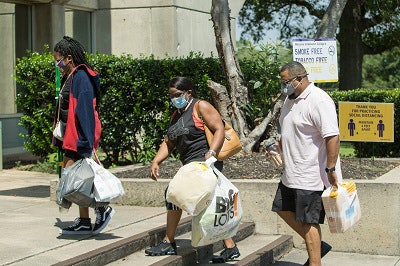Over the summer, Dr. Roslyn Clark Artis, president of Benedict College, spent as much time urging students to stay home and take their classes remotely this fall as she did preparing to welcome those students who told her they “need” to live and learn on the Columbia, South Carolina campus. Monday, August 10, is the first day of classes at the private, historically Black college — and the start of a fall semester that Artis warned early and often “is not going to be normal. And it’s not going to be the Benedict that you remember.”
 Dr. Roslyn Clark Artis
Dr. Roslyn Clark ArtisWithin days of re-opening Benedict, Artis decided to quickly pivot from offering a hybrid of in-person and virtual classes as the number of cases in the state climbed to an alarming high. So, for the first two weeks of the new semester, she said, classes, even for those living on campus, will be virtual.
About now, the small, southern campus that has been on pause since the COVID-19 pandemic drove students home in March would have been bustling with the excitement of a fall start. And it would have been filled with the lightness of students back together again and standing close. Instead, campus leaders must now assume the role of public health watchdogs.
With nearly every space on the campus “marked off and measured, from elevators to stairwells, dorm rooms and class rooms,” they will need to keep their students physically distant; make sure that they’re wearing face masks at all times, on campus; and move orderly through the COVID-19 testing and temperature check lines set up on campus.
Ahead of students’ arrival came box loads of personal protective equipment or PPE and test kits, and there were aggressive cleaning protocols that followed.
“As you can imagine, we are going over every surface,” Artis told Diverse. “I feel incredibly confident. The Department of Health and Environmental Control has reviewed our plan and told us that it was one of the most thorough they’ve seen, and it should be a model for other institutions. I’m confident that we’ve done everything within our power to protect our students, faculty and staff.”

But even with about half of Benedict’s 1,800 students returning to campus, keeping them safe against a deadly virus will be difficult.
“The risk of contracting the coronavirus is extraordinary,” and on a college campus, “the risk of spread is high,” said Dr. Jean Chin, an associate clinical professor of medicine at the University of Georgia, who is also chairing the American College Health Association’s COVID-19 task force.
Still, Artis said she is willing to own the “tremendous risk” that comes “with opening the campus in the middle of a COVID-19 pandemic,” and in South Carolina where positive cases of the virus neared 100,000 in early August. In her view are those students with the greatest need — about 900. With 50% fewer students on campus this semester, Benedict will face a financial hit, she said, but a campus home is where they belong.
“As we think about risks, there is an inherent risk in my not opening [the campus],” said Artis of those Benedict students who don’t have laptops and other devices of their own (nearly 35%); who don’t have access to Wi-Fi (12%); who live in crowded, multi-generational households where they can be exposed to the coronavirus; or who are experiencing homelessness and hunger.
When she looks outside the campus gates, Artis sees what she can’t control — a city and state on fire. Black people in South Carolina account for just under a third of the population but nearly 50% of COVID-19 deaths, according to a data brief that the South Carolina Institute of Medicine and Public Health and the S.C. Department of Health and Environmental Control released in June.
“So, to some extent,” Artis added, “those young people are actually safer here [Benedict College], where we have provided cleaning supplies, protocols, social distancing.”



















